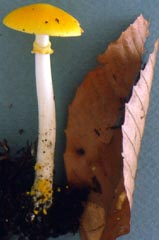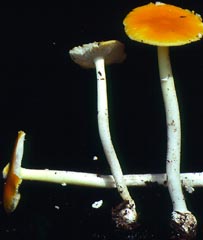|
[ Section Validae page. ]
[ Amanita Studies home. ]
[ Keys & Checklist/Picturebooks ] "Peck's Yellow Dust Amanita"
Technical description (t.b.d.) BRIEF DESCRIPTION: The cap of this species is 33 - 45 mm wide and usually a vivid yellow, sometimes orange-yellow, occasionally yellow with an irregular orange area near or over the center, broadly bell-shaped to convex to plano-convex. The flesh is up to 4 mm thick above the stem. The margin is nonstriate (except possibly in age) and nonappendiculate. The volva is absent or randomly distributed in crumb-like, floccose warts; these are easily removed and yellow. The gills are free, subcrowded to crowded, off-white to cream in mass, pale cream in side view, up to 3 mm broad, with a white edge despite the yellow pigment in the annulus. The stem is up to 110 x 4 - 10 mm, white (except occasionally above the annulus), narrowing upward, barely flaring at the apex, finely fibrillose below the annulus, finely pruinose above the annulus. The flesh of the stem is white, solid in part, stuffed in part, with a central cylinder up to 4 mm wide. The stipe's bulb is fusiform to ellipsoid to subclavate to subnapiform and up to 20 x 13 mm. The annulus is superior, small, skirt-like, pale yellow to yellow (rarely whitish) and striate above. The lower side of the annulus is smooth closer to the color of the volva of which some remnants may remain below the annulus' edge. The volva is yellow, friable, and often found in sparse fragments around the bulb or on the lower stem. Alternatively, the volva may take the form of a slight limb at the base of the stem or may be difficult to locate or left in the soil when the mushroom is collected. Amanita elongata has no distinct odor. The spores measure (6.8-) 7.5 - 10.5 (-12.5) x (4.0-) 5.0 - 6.9 (-8.7) Ám and are ellipsoid (infrequently elongate, infrequently broadly ellipsoid) and amyloid. Clamps are absent from bases of basidia. This species can usually be easily distinguished in the field from its probable close relative Amanita flavoconia G. F. Atk. var. flavoconia because of its white stem and its often nearly pure yellow cap. The stem, however, may infrequently have a pale yellow region above the annulus; and the cap may infrequently have an irregular small area of orange near the center or even be as strongly orange-yellow as in the picture on the right, above. The larger, narrower spores of A. elongata are the deciding factor in determining these cases. The species has been largely ignored in the literature, The species is known from conifer and oak forests in southeastern Canada at least as far north as the Island of Newfoundland (boreal forest in Gros Morne Nat. Pk.) and the northeastern USA at least as far south as the eastern shore of the Chesapeake Bay in Maryland and the mountains of western South Carolina (pine-oak forest). It may be more common in the northern half of that range; I have found and been given a number of collections from Maine and Newfoundland. Beech (Betula) may also be a symbiont of this species. For a set of similar taxa, see the list of species provided for Amanita flavoconia var. flavoconia. Of the taxa listed on that page, the most similar to the present species seems to be A. flavivolva Murrill. -- R. E. Tulloss Photos: R. E. Tulloss (left, Maine); Dr. Samuel S. Ristich (right, Maine).
[ Section Validae page. ]
[ Amanita Studies home. ]
[ Keys & Checklist/Picturebooks ] Last changed 2 October 2009. |

